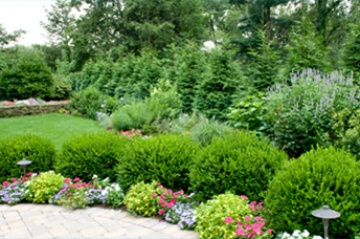Deer and Tick Control
Safe and effective deer repellants are a smart way to avoid thousands of dollars of irreparable unsightly damage to your ornamental trees and shrubs.
Deer Repellants
Deer can cause thousands, or even tens of thousands, of dollars in damage to ornamental trees and shrubs. The damage can occur at any time of year and tends to be worse in the winter when there are fewer native plants in the woods for deer to feed on and when the snow covers what little native browsing material is available.
Deer are creatures of habit. They tend to feed in the same places at the same times every day, following a route. The goal of protecting your plants is to not become part of a deer feeding route. Just because you have not experienced deer damage in the past, does not mean it will not happen. A change in weather or snow cover, or if your neighbors have a deer repellant applied to their susceptible trees and shrubs, can shift a feeding pattern to your yard. The damage done within just a few days of when deer decide they like your yard and your trees and shrubs can be costly and sometimes irreparable.
Deer feeding can do extreme damage to American arborvitae, rhododendrons, evergreen azaleas, cherry trees, plum trees, European mountain ash, wintercreeper euonymus, apples and crabapples, Atlantic white cedar, blue holly, pear trees, Cornelian cherry, flowering dogwood, Japanese holly, Hinoki cypress, Leyland cypress, mountain laurel, hydrangea, white and red oak, winger euonymus, and other trees and shrubs.
Safe and effective deer repellents are a smart way to avoid thousands of dollars in irreparable, unsightly damage to your ornamental trees and shrubs.
Tick Control
In the northeastern United States, the deer tick (Ixodes dammini) is the primary vector of Borrelia burgdoferi, the bacterium that causes Lyme disease.
In endemic areas it is estimated that one-fifth to one-third of deer tick nymphs are infected with Borrelia burgdoferi and that one-half of deer tick adults are infected. In turn, because of multiple tick bites on tick hosts, it is estimated that nearly all host mammals in widespread areas have been exposed to the bacterium. If deer ticks feed on infected hosts like white-tailed deer or white-footed mice, and then feed on you, your child, or your pet, they can transfer the Borrelia burgdorferi from an infected blood host to your family.
The most effective times for controlling ticks are at population peaks. Deer ticks have a complex two-year life cycle. Nymph populations peak in mid spring and adult populations peak in the fall. Accordingly, these are the best opportunities to kill deer ticks in your yard. Ticks move onto your property between these applications on deer, white footed mice, birds, or any of the other various blood hosts they have. Accordingly, for maximum protection, we also offer early spring and mid/late summer tick control applications.
Anyone can go out and spray pesticides around haphazardly and call it tick control. Effective control of deer ticks requires great attention to detail: proper mix ratio, recognition of habitats that ticks favor, and the appropriate equipment. In conjunction with our tree and shrub care programs, we can provide very effective tick control, thereby minimizing the possibility someone in your family will contract Lyme Disease.





